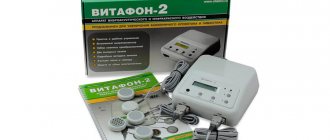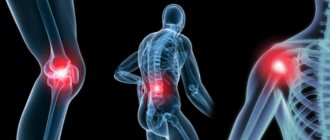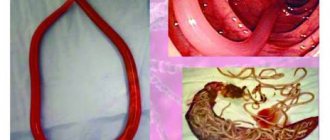Humeroscapular periarthritis (ICD 10 code - M75) is the most common cause of pain in the shoulder joint against the background of dystrophic lesions of the cervical spine. Pain syndrome is difficult to treat and leads to a decrease in quality of life and ability to work. In patients, the range of motion in the shoulder joint is limited, and the function of the upper limb is impaired. At the Yusupov Hospital, examinations are carried out using the latest diagnostic devices from leading European and world manufacturers.
Doctors take an individual approach to choosing a treatment method for each patient. For drug therapy, effective drugs are used that have minimal side effects. Rehabilitation specialists use innovative methods of rehabilitation therapy aimed at relieving pain and restoring movement in the shoulder joint. The medical staff is attentive to the wishes of patients.
Humeral periarthritis accounts for approximately 70% of lesions of the shoulder joint. This disease affects both young and old people. The peak of the disease occurs at 40-50 years of age. Which doctor treats glenohumeral periarthritis? At the Yusupov Hospital, an orthopedist, rheumatologist, and rehabilitologist treat patients suffering from joint disease. Severe cases of glenohumeral periarthritis are discussed at a meeting of the Expert Council with the participation of professors and associate professors, doctors of the highest category.
Causes of glenohumeral periarthritis
Humeroscapular periarthritis can develop after a shoulder injury, sudden and excessive physical exertion, or forced long-term immobility. Typically, several days pass from the moment of injury or overload before pain and inflammation occur. An acute attack of pain lasts several weeks.
The following diseases can contribute to the development of the pathological process:
- Diabetes;
- Obesity,
- Pathology of internal organs.
In some diseases of the cardiovascular system (myocardial infarction, coronary heart disease, peripheral vascular pathology), blood circulation deteriorates, especially in the left shoulder area, and glenohumeral periarthritis occurs. A common cause of the disease is osteochondrosis of the cervical spine, intervertebral hernia. Damaged vertebral discs wear out over time and lose their elastic properties. The distance between them decreases, the vertebrae come closer and pinch the nerve endings. When nerves are pinched, a reflex spasm of blood vessels occurs and blood circulation is disrupted. Inflammation of the shoulder tendons causes pain.
There are several theories that explain the mechanism of development of glenohumeral periarthritis. Muscle overstrain, professional overload, macrotrauma and microtrauma cause reactive inflammation in the tissues located around the joint, and reflex muscle-tonic reactions in the muscles that fix it contribute to the development of the degenerative process. In tissues with poor blood supply, as a result of constant tension and microtrauma, ruptures of individual fibrils are observed, foci of necrosis, hyalinization and calcification of collagen fibers are formed. Local damage to the periarticular tissues in the shoulder area is caused by the fact that the short rotators of the shoulder and the biceps tendon are constantly exposed to high functional load, often under conditions of compression, since the tendons are located in a narrow space.
Classification
Periarthrosis is a collective term that includes several pathologies that differ in location and nature of the lesion:
- Rotator cuff tendonitis is an inflammation of the rotator cuff muscles (supraspinatus, infraspinatus, teres minor, and subscapularis).
- Biceps tendinitis is an inflammation of the biceps tendon.
- The concept of calcific tendinitis is separately distinguished - an inflammatory process in the tendons of the shoulder muscles, occurring with a predominance of proliferation and the formation of multiple calcifications
- Partial or complete rupture of the tendons of the shoulder muscles.
- Retractile capsulitis is a degenerative-dystrophic lesion of the capsule of the shoulder joint.
- Impingement syndrome is a pathological process triggered by pinching of the biceps tendons and rotator cuff muscles between the head of the humerus and the end of the scapula.
Reference!
Doctors often call the collective pathology frozen shoulder syndrome, painful shoulder, cervicobrachial syndrome, and shoulder arthropathy.
Symptoms and diagnosis of glenohumeral periarthritis
In the clinic of glenohumeral periarthritis, the main one is pain. The pain usually occurs for no apparent reason, sometimes at night, when lying on the painful side. It can be aching or sharp, intensifies with movement and radiates to the neck or upper limb. Pain may occur when the arm is abducted, placed behind the back or behind the head. Painful areas are identified in the teres major and pectoralis major muscles. Pain also occurs when the shoulder is abducted to 60-90°, which is associated with damage to the supraspinatus tendon.
The second important sign of glenohumeral periarthritis is contractures (stiffness) in the shoulder joint. The range of movements suffers sharply. When the arm is abducted, the scapula immediately moves (normally, it begins to rotate around its sagittal axis after the shoulder is abducted to 90°). The patient is unable to maintain the upper limb in lateral abduction. Rotation of the shoulder, especially inward, is difficult, but pendulum-like movements of the shoulder within 40° remain free.
When x-raying a joint, doctors identify the following signs:
- Osteosclerosis;
- Uneven or unclear bone contour;
- Deformation;
- Osteophytes (bone growths) at the sites of attachment of ligaments to the greater tubercle.
X-rays show osteoporosis in the area of the greater tuberosity or near the joint. Single or multiple clearings of bone tissue are visible in the area of the greater tubercle and humeral head, similar to a cyst. It is often possible to see calcifications in linear soft tissues. They are located under the acromion process of the scapula.
Doctors at the Yusupov Hospital make a diagnosis based on clinical manifestations and X-ray examination of the shoulder joint. In the most complex cases of glenohumeral periarthritis, magnetic resonance imaging is performed. It allows you to enhance the contrast of the image, which allows you to clearly differentiate soft tissue structures. The method avoids radiation exposure and provides horizontal, sagittal and frontal tomographic sections with reliable information about the magnitude of pathological changes.
General clinical recommendations
Persons suffering from shoulder arthrosis are advised to:
- lead a healthy, active lifestyle, alternating physical activity and rest;
- eat properly regularly;
- get rid of all bad habits;
- regularly perform therapeutic exercises, avoiding sudden movements;
- at night sleep on your back or on your healthy side, placing a small pillow under your sore arm;
- avoid heavy physical activity, avoid injuries, prolonged stress and colds;
- in case of exacerbation (development of synovitis), avoid any thermal procedures;
- follow all recommendations of the attending physician.
Prevention
It is especially important for persons with a family history to follow certain rules for the prevention of shoulder arthrosis. They should not engage in weightlifting, tennis, hazardous sports, or work as hammer hammers, blacksmiths, or miners. Anyone who wants to have healthy joints should lead an active lifestyle and eat regularly.
Treatment of glenohumeral periarthritis
How to treat glenohumeral periarthritis? Conservative treatment of glenohumeral periarthritis begins with measures aimed at stopping the influence of provoking factors. First of all, limit the load on the affected joint. The patient is allowed movements that do not cause increased pain. In case of very severe pain, provide rest and immobilization of the affected limb for several hours a day (wearing the arm in a scarf). When pain decreases, physical therapy is prescribed. It is aimed at strengthening the muscles of the shoulder girdle, preventing future exacerbations. Gymnastics for glenohumeral periarthritis for the muscles of the shoulder girdle includes internal and external rotation, abduction.
Rehabilitation specialists use various methods of reflex therapy (physiotherapeutic procedures, acupuncture, segmental acupressure). The severity of pain is reduced by the use of electrophoresis of 0.5% or 2% novocaine solution. Sinusoidal simulated currents, including SMT phoresis of drugs, have a good therapeutic effect in scapulohumeral periarthritis. Subsequently, patients undergo mud applications and general sulfide baths. Good results are described with the combined use of ultrasound (US) therapy and SMT. For pain in the shoulder girdle, the following physiotherapeutic procedures are used in combination:
- Decimeter waves;
- Electrical stimulation;
- Electrophoresis of medicinal substances;
- Magnetotherapy.
Good results are achieved by combining microwave therapy with interference currents.
Drug treatment for glenohumeral periarthritis is aimed at reducing the severity of pain and tissue swelling, relieving muscle spasm and increasing the functional state of the shoulder joint. The degeneration process is affected with the help of chondroprotectors. To relieve pain, local blockade of trigger and painful points is performed with a 1–2% lidocaine solution or a 0.5%–2% procaine solution. Hydrocortisone and vitamin B12 are added to the local anesthetic solution. For lesions located near the shoulder joint, local treatment with glucocorticosteroids is performed.
Simple analgesics (paracetamol), non-steroidal anti-inflammatory drugs and muscle relaxants are widely used to reduce and relieve pain. In cases of severe pain, in some cases they resort to the use of narcotic analgesics - tramadol or a combination thereof.
In the complex treatment of glenohumeral periarthritis, pharmacological agents are used that stimulate the production of components of connective and cartilaginous tissue (including spinal structures), slow down their destruction, and thereby prevent the progression of degenerative changes. These include chondroitin sulfate and glucosamine.
Conducting physical therapy
In order for a speedy recovery to occur, you should use therapeutic exercises. A big plus is doing exercises in water. Swimming and hydrokinesotherapy are an integral part of the recommended complex during glenohumeral periarthritis. Exercising in the pool normalizes muscle tone, relieves excess tension, and increases the mobility of the damaged joint.
If we talk about the goals of the gymnastics complex, we can highlight:
- Blood flow is normalized.
- Tissues are enriched with oxygen.
- Stagnation is eliminated.
- Muscles are strengthened.
- Metabolic processes are normalized.
It should be remembered that physical therapy is contraindicated if glenohumeral periarthritis is in the acute stage or if there is severe pain in the joint.
Exercise therapy for glenohumeral periarthritis
At the initial stage of treatment of glenohumeral periarthritis, patients do the following exercises from the starting position “lying”:
- They clench and unclench their fingers, shake the brush;
- Bend your arms at the wrist joint;
- Holding your arms along your body, turn your palms down and up;
- Keep your arms along the body, while inhaling, bring your hands to your shoulders, and while exhaling, lower them.
You can bend your elbows and spread your forearms to the sides, bringing the back of your hand as close as possible to the horizontal surface. The hands should be kept on the shoulders, the elbows in front of you, as you inhale, spread the elbows to the sides, and as you exhale, place them vertically again.
The following exercises for shoulder osteoarthritis are done while sitting:
- Place your hands on your waist, spread your elbows to the side and bring them towards each other at low speed;
- Hands are located at the waist, simultaneously rotate both shoulders forward and backward;
- As you inhale, bend your elbows, and as you exhale, lightly swing them back and forth;
- Place your hand behind your back and raise your palm to your shoulder blade.
Rehabilitation specialists at the Yusupov Hospital select an individual set of exercises for each patient for glenohumeral periarthritis. These exercises are suitable for treating the disease at home.
Massage for glenohumeral periarthritis
Massage for glenohumeral periarthritis is an important component of the treatment course and recovery process. Massage is combined with drug treatment, which will ensure a faster recovery. The method is aimed at preventing a decrease in joint activity and the development of rough scar tissue. muscle atrophy. It allows you to quickly restore the function of the upper limbs. In the acute phase of the disease, massage is not used.
With the help of massage, the collar area, glenohumeral joint and shoulder, deltoid and pectoralis major muscles are affected. Manual therapy is carried out only after acute inflammation in the joint capsule has been relieved and pain has been reduced. The procedures are carried out 14–20 days after immobilization of the joint. This allows you to obtain a pronounced therapeutic effect. Complete a course of effective treatment for glenohumeral periarthritis by making an appointment with a doctor by calling the contact center of the Yusupov Hospital.
Complications
The most dangerous complication of glenohumeral periarthrosis is adhesive capsulitis, which within 3-4 months can lead to contracture (limited movement or complete immobility). Connective tissue (scar) actively growing in the joint capsule deforms the synovial membrane, involves muscles and ligaments in the scar, reducing the range of motion in the joint (“frozen shoulder symptom”).
The disease is insidious in that even with a full range of therapeutic and rehabilitation measures, movement in the shoulder may not be fully restored.
The most common complication of untreated tendinitis is rupture of degenerative tendons and ligaments, which can lead to permanent dysfunction and even dislocation of the shoulder.
Untreated tendinitis can be complicated by purulent inflammation of the joint capsule (bursitis ). Without surgical intervention (removal of exudate), the tendons and bursa become fused and deformed, which leads to limited range of motion.
The spread of the inflammatory process to a wide tendon strip covering the muscles of the shoulder (aponeurosis) ends with the formation of local or extensive foci of connective tissue replacement, which limits the range of motion in the joint.









